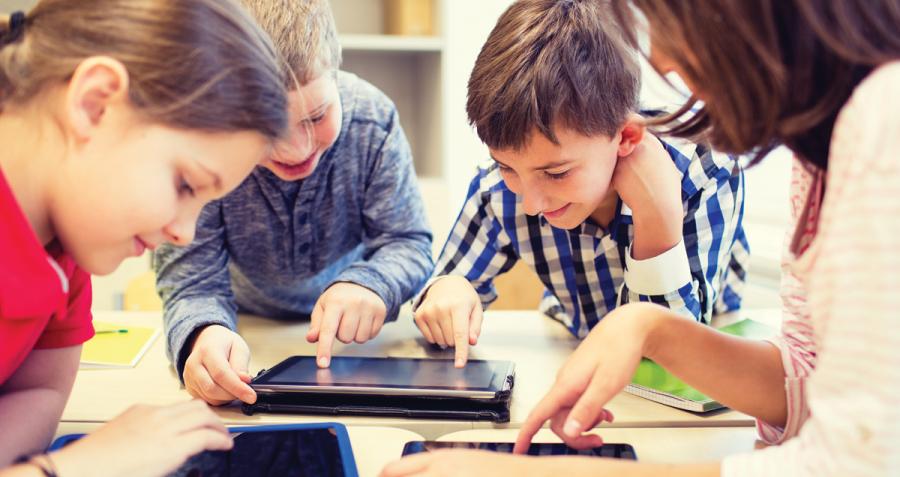For so long, the classroom was the setting of chalk-scribbled blackboards and unwieldy overhead projectors loaded up with plastic sheets. Now, technology is transforming the way teachers teach and students learn. From 3D printers and games-based learning to assistive technology designed to help students with learning difficulties, the modern classroom bears no resemblance to the school environments many of us grew up in.
Here we look at five ways technology is helping our kids as well as their teachers.
Thinking out loud
There’s a world of gadgets out there designed to help take the lesson off the page and stream it into young minds. Smartpens such as the Livescribe Echo record what the student writes, says and hears. Students can then transfer this information to a computer through a USB cable, where Echo Desktop will save it for fast, easy access and sharing.
Software that converts the written word into speech is an especially useful addition to the classroom, especially for students with dyslexia. Programs such as Proloquo2Go use thousands of symbols to help students with speech difficulties create sentences that are then spoken aloud to their teacher.
There is also a range of talking calculators that can take some of the confusion out of numbers.
Gamification
“Game design isn’t just technological craft. It’s a 21st century way of thinking and leading,” writes Jane McGonigal in Reality Is Broken: Why Games Make Us Better and How They Can Change the World (2011). While many parents may be worried about the amount of screen time their kids are getting, the upside is that schools are tapping into this new way of absorbing information.
The International Computer and Information Literacy Study found 50 per cent of Australian children had used computers before they were 6½ years old, well above the global average of 36 per cent. Rather than fight the iPad, schools are putting it to good use, turning lessons into Minecraft-style treasure hunts: customisable classroom management systems such as ClassRealm can gamify any lesson, be it maths, science or English while educational game design package, Gamestar Mechanic, and behaviour-management system Class Dojo, enable teachers enrich class participation by using technology kids are familiar.
3D printing
The 3D printer is a game changer for so many industries, with its capacity to produce everything from small houses to functional cars. In schools, however, printing in 3D helps students develop skills for future careers, particularly for professions that use more technical CAD (computer-aided design) programs, such as architecture, engineering, medical device manufacturing and even music and film production.
It’s also a great resource for teachers: with the price of 3D printers falling rapidly, schools will soon have the capacity to print models of historical artifacts, rare specimens or concrete representations of mathematical and scientific theories.
“Working within 3D design environments supports young children to develop spatial awareness,” says Mandi Dimitriadis, director of learning development at Makers Empire, a 3D printing software specifically designed for K-10 classrooms. “It also allows them to visualise and conceptualise abstract concepts in concrete ways.”
Robotics
A report by the Committee for Economic Development of Australia declares technology could replace 40 per cent of jobs in Australia by 2025.
Understanding what this means is crucial to the future of our youth and the workforce. Queensland was the first state to make robotics compulsory in all state schools, with others following suit over the next few years.
Robotics is a wonderfully inclusive way for students, especially those on the autism spectrum, to develop teamwork skills and self-confidence, the creative thinking needed to solve real-world problems and explain complex technology. Lego Mindstorms, Sphero and the VEX Robotics design systems are also worth checking out.
Coding
“Students need to have skills in all forms of literacy – and digital literacy is one of them,” says Bec Spink, assistant principal at Victoria’s Aitken Creek Primary School and co-founder and director of Code the Future. “We teach coding in order to turn kids into creators and inventors, not just consumers.”
The flow-on effect is huge, Spink says. “We had some Year 2s – so we’re talking five-and-six-year-olds – write their own game using visual coding. Doing so had them learning Cartesian planes, angles and geometry – things that aren’t in the curriculum until much later. They now know these subjects, can explain them and apply them. That’s incredibly powerful.”
While there’s considerable debate around the amount of time our school-age children are spending in front of a screen, for the teaching profession, the rapid progression of technology will revolutionise how kids experience the classroom. At the very least, the teeth-tingling sound of chalk screeching down a blackboard will never be heard again.
With innovation a focus for EnergyAustralia, it’s examples of ingenuity like this that will inspire us in the future.




